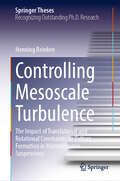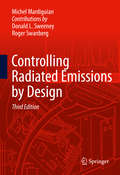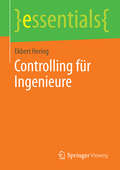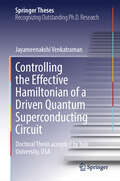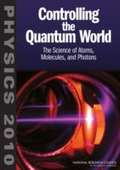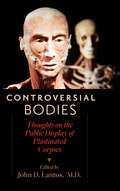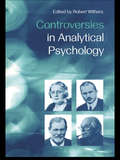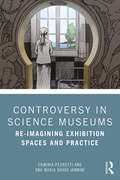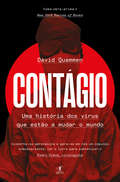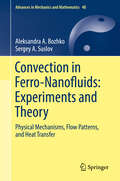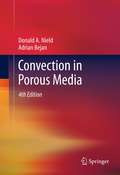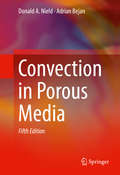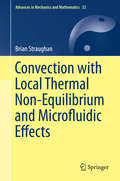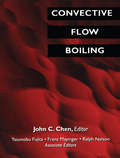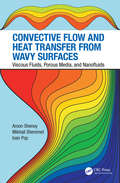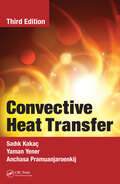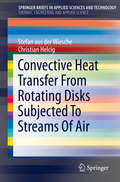- Table View
- List View
Controlling Light in Optically Induced Photonic Lattices (Springer Theses)
by Bernd TerhalleDiscrete periodic structures play an important role in physics, and have opened up an exciting new area of investigation in recent years. Questions relating to the control of light in such structures still represent a major challenge. It is this highly active field that is addressed in the present thesis. Using the model system of a photorefractive nonlinearity that allows one to simultaneously create and control photonic lattices by light, the author obtains a comprehensive picture of the control of nonlinear and quantum optics phenomena in photonic lattices. He describes and demonstrates experimentally for the first time resonant transitions in two-dimensional hexagonal lattices, including Rabi oscillations and Landau-Zener tunneling, as well as the direct control and exploitation of these transitions. A particular highlight of this thesis is the study of soliton-cluster switching and control of Zener tunneling.
Controlling Mesoscale Turbulence: The Impact of Translational and Rotational Constraints on Pattern Formation in Microswimmer Suspensions (Springer Theses)
by Henning ReinkenThis thesis combines methods from statistical physics and nonlinear dynamics to advance research on the pattern formation in active fluids in several directions. In particular, it focuses on mesoscale turbulence, a state observed in microswimmer suspensions, which is characterized by the emergence of dynamic vortex patterns. The first major contribution concerns the bottom-up derivation of a frequently used continuum model of mesoscale turbulence from a set of particle-resolved stochastic equations. Utilizing the model, mesoscale turbulence is shown to induce nontrivial transport properties including a regime of optimal diffusion. The thesis then explores possible strategies of control. One of these relies on an external field that leads to stripe-like structures and can even suppress patterns entirely. The other involves geometric confinement realized by strategically placed obstacles that can reorganize the flow into a variety of ordered vortex structures. The turbulence transition inside an obstacle lattice is shown to have an intriguing analogy to an equilibrium transition in the Ising universality class. As a whole, this thesis provides important contributions to the understanding and control of turbulence in active fluids, as well as outlining exciting future directions, including applications. It includes a substantial introduction to the topic, which is suitable for newcomers to the field.
Controlling Radiated Emissions by Design (The\springer International Series In Engineering And Computer Science Ser. #580)
by Michel MardiguianThe 3rd edition of Controlling Radiated Emissions by Design has been updated to reflect the latest changes in the field. New to this edition is material on aspects of technical advance, specifically long term energy efficiency, energy saving, RF pollution control, etc. This book retains the step-by-step approach for incorporating EMC into every new design, from the ground up. It describes the selection of quieter IC technologies, their implementation into a noise-free printed circuit layout, and the gathering of all these into low radiation packaging, including I/O filtering, connectors and cables considerations. All guidelines are supported by thorough and comprehensive calculated examples. Design engineers, EMC specialists and technicians will benefit from learning about the development of more efficient and economical control of emissions.
Controlling für Ingenieure (essentials)
by Ekbert HeringControlling stellt ein ziel-, nutzen- und engpassorientiertes Führungskonzept dar, mit dem Unternehmen kurz-, mittel- und langfristig erfolgreich geführt werden können. Die Ziele werden in Planungen festgehalten, die messbare Soll-Werte enthalten. Werden die tatsächlichen Ist-Werte gemessen, so kann man die Abweichungen von den Planwerten feststellen. Diese Abweichungen lösen eine Steuerung durch Anpassungsmaßnahmen zur Zielerreichung oder Korrektur der Zielgrößen aus. Es wird zwischen strategischem und operativem Controlling unterschieden. Das strategische Controlling dient zur Existenzsicherung, indem es die langfristigen Ziele anhand der Erkenntnisse über zukünftige Marktchancen und -risiken unter Berücksichtigung der eigenen Möglichkeiten und Stärken festlegt. Aufgabe des operativen Controllings ist die Sicherung der Lebensfähigkeit des Unternehmens (Liquidität), einer angemessenen Verzinsung des eingesetzten Kapitals (Rentabilität) sowie ein optimales Kosten- und Leistungsverhältnis (Wirtschaftlichkeit). Strategisches und operatives Controlling werden für alle Funktionen des Unternehmens erläutert.
Controlling the Effective Hamiltonian of a Driven Quantum Superconducting Circuit (Springer Theses)
by Jayameenakshi VenkatramanThe thesis illustrates, with a remarkable combination of theoretical analysis and experimental investigation, how the static Hamiltonian of an oscillator with both 3rd and 4th order non-linearity can morph into a profoundly different Hamiltonian under the influence of an oscillating driving force. In a classical system, such transformation would not be considered a novelty, but the author demonstrates that the new Hamiltonian can possess an exotic symmetry with surprising new quantum properties that one would never anticipate from the original Hamiltonian, with no classical equivalent. The root cause of these unexpected properties is a subtle interference effect, which is only possible in a quantum context. Carefully crafted control experiments ensure that measured data are compared with theoretical predictions with no adjustable parameters. Instrumental in this comparison is a new diagrammatic theory developed by the author.
Controlling the Quantum World of Atoms, Molecules, and Photons: An Interim Report
by National Research Council of the National AcademiesAs part of its Physics 2010 decadal survey, the NRC has undertaken a study of opportunities in atomic, molecular, and optical (AMO) science and technology over roughly the next decade. This study has been requested by the Department of Energy and the National Science Foundation. They asked the NRC to assess the state of AMO science, emphasizing recent accomplishments and identifying new and compelling scientific questions. A final report on this study is expected in the summer 2006. This interim report provides a preview of the final document. It presents a summary of the key opportunities in forefront AMO science and in closely related technologies, and a discussion of some of the broad-scale conclusions of the final report. The interim report also describes how AMO science supports national R&D priorities.
Controlling the Quantum World: The Science of Atoms, Molecules, and Photons
by National Research Council of the National AcademiesAs part of the Physics 2010 decadal survey project, the Department of Energy and the National Science Foundation requested that the National Research Council assess the opportunities, over roughly the next decade, in atomic, molecular, and optical (AMO) science and technology. In particular, the National Research Council was asked to cover the state of AMO science, emphasizing recent accomplishments and identifying new and compelling scientific questions. Controlling the Quantum World, discusses both the roles and challenges for AMO science in instrumentation; scientific research near absolute zero; development of extremely intense x-ray and laser sources; exploration and control of molecular processes; photonics at the nanoscale level; and development of quantum information technology. This book also offers an assessment of and recommendations about critical issues concerning maintaining U.S. leadership in AMO science and technology.
Controversial Bodies: Thoughts on the Public Display of Plastinated Corpses
by John D. LantosControversial, fascinating, disturbing, and often beautiful, plastinated human bodies—such as those found at Body Worlds exhibitions throughout the world—have gripped the public's imagination. These displays have been lauded as educational, sparked protests, and drawn millions of visitors. This book looks at the powerful sway these corpses hold over their living audiences everywhere.Plastination was invented in the 1970s by German anatomist Gunther von Hagens. The process transforms living tissues into moldable plastic that can then be hardened into a permanent shape. Von Hagens first exhibited his expertly dissected, artfully posed plastinated bodies in Japan in 1995. Since then, his shows have continuously attracted so many paying customers that they have inspired imitators, brought accusations of unethical or even illegal behavior, and ignited vigorous debates among scientists, educators, religious leaders, and law enforcement officials. These lively, thought-provoking, and sometimes personal essays reflect on such public displays from ethical, legal, cultural, religious, pedagogical, and aesthetic perspectives. They examine what lies behind the exhibitions' popularity and explore the ramifications of turning corpses into a spectacle of amusement. Contributions from bioethicists, historians, physicians, anatomists, theologians, and novelists dig deeply into issues that compel, upset, and unsettle us all.
Controversies in Analytical Psychology
by Robert WithersHow can controversy promote mutual respect in analytical psychology?Analytical psychology is a broad church, and influences areas such as literature, cultural studies, and religion. However, in common with psychoanalysis, there are many different schools of thought and practice which have resulted in divisions within the field. Controversies in Analytical Psychology picks up on these and explores many of the most hotly contested issues in and around analytical psychology.A group of leading international Jungian authors have contributed papers from contrasting perspectives on a series of key controversies. Some of these concern clinical issues such as what helps patients get better, or how closely analysts should work with the transference. Other contributions focus on the relationship between analytical psychology and other disciplines including evolutionary theory, linguistics, politics and religion. A critical eye is cast over Jungian theories and practices, and a number of questions are raised:* are they homophobic?* do they denigrate women?* do they confuse absolute with narrative truth?* are the frequency of sessions chosen for political rather than clinical reasons?Controversies in Analytical Psychology encourages critical thinking on a variety of issues, helping foster dialogue and investigation in a climate of mutual respect and understanding. It will be invaluable for Jungian analysts and psychoanalysts in training and practice and psychotherapists.
Controversies in Hepatocellular Carcinoma
by Nancy S. Reau Amit G. SingalThis book is written for clinicians who care for patients with hepatocellular carcinoma (HCC) as well as health services researchers doing work in this area. The Editors and authors cover some of the emerging controversial topics that come up in HCC clinical practice and research. There are over 30 questions ranging from screening and diagnosis to therapeutics and survivorship. Chapters are begin with a controversy and the authors defend or refute the question. Comprehensive and unique, this book aims to help with management of this patient population.
Controversies in Neuro-Ophthalmology
by Jacinthe Rouleau Reid Longmuir Andrew G LeeNeuro-ophthalmology, like in any field of medicine, has many areas where controversy exists in diagnosis and treatment. Controversies in Neuro-Ophthalmology provides a comprehensive overview on the clinical presentation, diagnosis, and management of neuro-ophthalmic disorders and specifically addresses areas where there is a general lack of consens
Controversies in Obstetric Anesthesia and Analgesia
by Ian McconachieMcConachie (anesthesia and perioperative medicine, U. of Western Ontario, Canada) assembles 21 articles by obstetrics practitioners caring for high-risk patients at the University of Western Ontario and in the UK who outline debates in obstetric anesthesia and analgesia used in the perioperative and perinatal periods, for trainees and practitioners in anesthesia, obstetrics, and critical care medicine, as well as nurses and midwives. They address substance abuse and cardiac disease in pregnancy; management of pre-eclampsia and eclampsia, hemorrhage, and postdural puncture headache; anesthetic drugs and the developing fetal brain; ultrasound-guided epidural anesthesia, combined spinal-epidural anesthesia, and other types; coagulation and regional anesthesia; ambulatory and patient-controlled epidural analgesia; hypotension following spinal anesthesia; outcomes; cesarean section airway management, oxygen supplementation, oxytocin use and dosage, and analgesia; and other topics. Basic knowledge and experience in obstetric physiology, pharmacology, and anesthesia is assumed. Annotation ©2012 Book News, Inc. , Portland, OR (booknews. com)
Controversies in the Technical Aspects of ACL Reconstruction: An Evidence-Based Medicine Approach
by Stefano Zaffagnini Robert G. Marx Norimasa Nakamura Volker MusahlThis book provides the reader with the best available evidence on the most pressing issues relating to reconstruction of the anterior cruciate ligament (ACL) with the goal of supporting surgical reconstruction of the ACL and improving outcomes for patients. Key topics for which evidence-based information is presented include selection of graft material and source, the use of different surgical techniques, graft rupture in relation to surgical technique, and progression to osteoarthritis. The book will aid the surgeon in making decisions with respect to fixation devices and tensioning, the bundles to be reconstructed, and whether to preserve remnants or partial bundle ruptures. An evidence-based stance is taken on evolving topics such as the anatomy of the tibial insertion site of the ACL and the role of the anterolateral capsule and posteromedial corner in high-grade rotatory instability. Furthermore, novel technical developments for measurement of knee laxity and soft tissue navigation are discussed. The reader will also find useful information on general issues concerning physical examination, arthroscopic setup, timing of reconstruction, anesthesia, and anticoagulation.
Controversy in Science Museums: Re-imagining Exhibition Spaces and Practice
by Erminia Pedretti Ana Maria Navas IanniniControversy in Science Museums focuses on exhibitions that approach sensitive or controversial topics. With a keen sense of past and current practices, Pedretti and Navas Iannini examine and re-imagine how museums and science centres can create exhibitions that embrace criticality and visitor agency. Drawing on international case studies and voices from visitors and museum professionals, as well as theoretical insights about scientific literacy and science communication, the authors explore the textured notion of controversy and the challenges and opportunities practitioners may encounter as they plan for and develop controversial science exhibitions. They assert that science museums can no longer serve as mere repositories for objects or sites for transmitting facts, but that they should also become spaces for conversations that are inclusive, critical, and socially responsible. Controversy in Science Museums provides an invaluable resource for museum professionals who are interested in creating and hosting controversial exhibitions, and for scholars and students working in the fields of museum studies, science communication, and social studies of science. Anyone wishing to engage in an examination and critique of the changing roles of science museums will find this book relevant, timely, and thought provoking.
Contágio
by David Quammen«Uma obra-prima.» New York Review of Books O livro mais importante e urgente para ler neste momento «É nossa a responsabilidade pela epidemia do novo coronavírus. Pode ter começado com um morcego numa gruta, mas foi a actividade humana que a disseminou.» David Quammen Num momento em que a Humanidade perde o chão com o tremendo impacto global da pandemia de um novo coranavírus, o SARS-CoV-2, é urgente ler o livro que previu este desastre viral e que nos diz como impedir que o mesmo volte a acontecer. À medida que a globalização ganha força e que invadimos ecossistemas milenares em prol de uma expansão económica sem limites, ficamos também à mercê de infecções perigosas que nos são transmitidas pelos animais que prosperavam nos habitats que destruímos. Doenças que estavam, antes, contidas e limitadas àquele espaço passam a circular entre os humanos com consequências catastróficas, como são disso exemplo a SIDA, o Ébola, a Malária e, mais recentemente, a COVID19. Na companhia dos melhores cientistas do mundo, mergulhando nas selvas centro-africanas, grutas da China meridional e telhados do Bangladesh, passando pelos laboratórios onde se investigam vírus altamente letais sob apertadas medidas de segurança, o conceituado autor de divulgação científica David Quammen conta-nos a história dos principais vírus zoonóticos que ameaçam os humanos e deixa um aviso: temos de nos preparar para o pior. Contágio, uma história dos vírus que estão a mudar o mundo é uma narrativa apaixonante, repleta de imprevistos, hipóteses e interrogações que, hoje, a braços com a nova pandemia de SARS-CoV-2, se tornou uma urgente chamada de atenção. «Arrepiante. Um livro brilhante e devastador.» Daily Mail Os elogios da crítica: «Pertinente e assustador.»New York Times «Uma leitura compulsiva plena de aventuras, contada a partir da linha da frente da prevenção de pandemias.»Wired «Quammen é um daqueles raros jornalistas científicos que mistura exploração com um talento inédito para a síntese e para a narrativa.»Nature «David Quammen é provavelmente o meu autor de ciência preferido: amável, erudito, subestimado, divertido, profundamente humano.»New York Magazine «David Quammen é o melhor escritor de história natural. Os seus livros impressionam pela sua precisão, energia e pela sua narrativa brilhante e evocativa.»The Wall Street Journal «Deslumbrante Quammen: revela o que nos faz viver e o que nos mata com paixão, humor e conhecimento.»Daniel Arjona, El confidencial «O facto de Quammen nunca ter recebido o prémio Pulitzer é uma autêntica vergonha.»Dwight Garner, The New York Times «Contágio é uma obra-prima fascinante do jornalismo científico que se lê como um policial.»Walter Isaacson, autor de Steve Jobs «Quammen é o melhor jornalista do mundo natural.»The New York Times «Um livro assustador, mas fundamental para entender a próxima pandemia global.»Publisher's Weekly «Um livro essencial.»Booklist «O livro que me ajudou a perceber a dinâmica do que estava a acontecer.» Paolo Giordano <p style="text-a
Convection Heat Transfer
by Adrian BejanA new edition of the bestseller on convection heat transfer A revised edition of the industry classic, Convection Heat Transfer, Fourth Edition, chronicles how the field of heat transfer has grown and prospered over the last two decades. This new edition is more accessible, while not sacrificing its thorough treatment of the most up-to-date information on current research and applications in the field. One of the foremost leaders in the field, Adrian Bejan has pioneered and taught many of the methods and practices commonly used in the industry today. He continues this book's long-standing role as an inspiring, optimal study tool by providing: Coverage of how convection affects performance, and how convective flows can be configured so that performance is enhanced How convective configurations have been evolving, from the flat plates, smooth pipes, and single-dimension fins of the earlier editions to new populations of configurations: tapered ducts, plates with multiscale features, dendritic fins, duct and plate assemblies (packages) for heat transfer density and compactness, etc. New, updated, and enhanced examples and problems that reflect the author's research and advances in the field since the last edition A solutions manual Complete with hundreds of informative and original illustrations, Convection Heat Transfer, Fourth Edition is the most comprehensive and approachable text for students in schools of mechanical engineering.
Convection in Ferro-Nanofluids: Physical Mechanisms, Flow Patterns, and Heat Transfer (Advances in Mechanics and Mathematics #40)
by Aleksandra A. Bozhko Sergey A. SuslovThis book covers the experimental and theoretical study of convection in non-isothermal ferro-nanofluids (FNFs). Since FNFs are not transparent and magnetic fields are very sensitive to the shape of the boundary between magnetic and nonmagnetic media, special flow visualization techniques based on the use of thermo-sensitive liquid crystal films, infrared cameras, as well as local and integral temperature sensors are discussed in the book. This book considers several major configurations of convective chambers and the applied magnetic field. For each of them, the stability boundaries are determined theoretically and experimentally. The physical types of dominant instabilities and the characteristics of their interactions are subsequently established using linear and weakly non-linear hydrodynamic stability analyses and elements of bifurcation theory. The book also discusses the potential of using magnetically controlled ferro-nanofluids as a heat carrier in situations where heat removal by natural convection is not possible due to the lack of gravity (orbital stations) or extreme confinement (microelectronics). Researchers and practitioners working in the areas of fluid mechanics, hydrodynamic stability, and heat and mass transfer will benefit from this book.
Convection in Porous Media
by Adrian Bejan Donald A. NieldConvection in Porous Media, 4th Edition, provides a user-friendly introduction to the subject, covering a wide range of topics, such as fibrous insulation, geological strata, and catalytic reactors. The presentation is self-contained, requiring only routine mathematics and the basic elements of fluid mechanics and heat transfer. The book will be of use not only to researchers and practicing engineers as a review and reference, but also to graduate students and others entering the field. The new edition features approximately 1,750 new references and covers current research in nanofluids, cellular porous materials, strong heterogeneity, pulsating flow, and more.
Convection in Porous Media
by Adrian Bejan Donald A. NieldThis updated edition of a widely admired text provides a user-friendly introduction to the field that requires only routine mathematics. The book starts with the elements of fluid mechanics and heat transfer, and covers a wide range of applications from fibrous insulation and catalytic reactors to geological strata, nuclear waste disposal, geothermal reservoirs, and the storage of heat-generating materials. As the standard reference in the field, this book will be essential to researchers and practicing engineers, while remaining an accessible introduction for graduate students and others entering the field. The new edition features 2700 new references covering a number of rapidly expanding fields, including the heat transfer properties of nanofluids and applications involving local thermal non-equilibrium and microfluidic effects.
Convection in Porous Media
by Adrian Bejan Donald A. NieldThis updated edition of a widely admired text provides a user-friendly introduction to the field that requires only routine mathematics. The book starts with the elements of fluid mechanics and heat transfer, and covers a wide range of applications from fibrous insulation and catalytic reactors to geological strata, nuclear waste disposal, geothermal reservoirs, and the storage of heat-generating materials. As the standard reference in the field, this book will be essential to researchers and practicing engineers, while remaining an accessible introduction for graduate students and others entering the field. The new edition features 2700 new references covering a number of rapidly expanding fields, including the heat transfer properties of nanofluids and applications involving local thermal non-equilibrium and microfluidic effects.
Convection with Local Thermal Non-Equilibrium and Microfluidic Effects (Advances in Mechanics and Mathematics #32)
by Brian StraughanThis book is one of the first devoted to an account of theories of thermal convection which involve local thermal non-equilibrium effects, including a concentration on microfluidic effects. The text introduces convection with local thermal non-equilibrium effects in extraordinary detail, making it easy for readers newer to the subject area to understand. This book is unique in the fact that it addresses a large number of convection theories and provides many new results which are not available elsewhere. This book will be useful to researchers from engineering, fluid mechanics, and applied mathematics, particularly those interested in microfluidics and porous media.
Convective Flow Boiling
by John C. ChenThis book comprises selected papers from the First International Conference on Convective Flow Boiling. The purpose of the conference is to examine state-of-science and recent developments in technology of flow boiling, i.e., boiling systems which are affected by convective flows.
Convective Flow and Heat Transfer from Wavy Surfaces: Viscous Fluids, Porous Media, and Nanofluids
by Aroon Shenoy Mikhail Sheremet Ioan PopConvective Flow and Heat Transfer from Wavy Surfaces: Viscous Fluids, Porous Media, and Nanofluids addresses the wavy irregular surfaces in heat transfer devices. Fluid flow and heat transfer studies from wavy surfaces have received attention, since they add complexity and require special mathematical techniques. This book considers the flow and heat transfer characteristics from wavy surfaces, providing an understanding of convective behavioral changes.
Convective Heat Transfer
by Yaman Yener Sadik Kakac Anchasa PramuanjaroenkijIntended for readers who have taken a basic heat transfer course and have a basic knowledge of thermodynamics, heat transfer, fluid mechanics, and differential equations, Convective Heat Transfer, Third Edition provides an overview of phenomenological convective heat transfer. This book combines applications of engineering with the basic concepts o
Convective Heat Transfer From Rotating Disks Subjected To Streams Of Air (SpringerBriefs in Applied Sciences and Technology)
by Stefan aus der Wiesche Christian HelcigThis Brief describes systematically results of research studies on a series of convective heat transfer phenomena from rotating disks in air crossflow. Phenomena described in this volume were investigated experimentally using an electrically heated disk placed in the test section of a wind tunnel. The authors describe findings in which transitions between different heat transfer regimes can occur in dependency on the involved Reynolds numbers and the angle of incidence, and that these transitions could be related to phenomenological Landau and Landau-de Gennes models. The concise volume closes a substantial gap in the scientific literature with respect to flow and heat transfer in rotating disk systems and provides a comprehensive presentation of new and recent results not previously published in book form.

